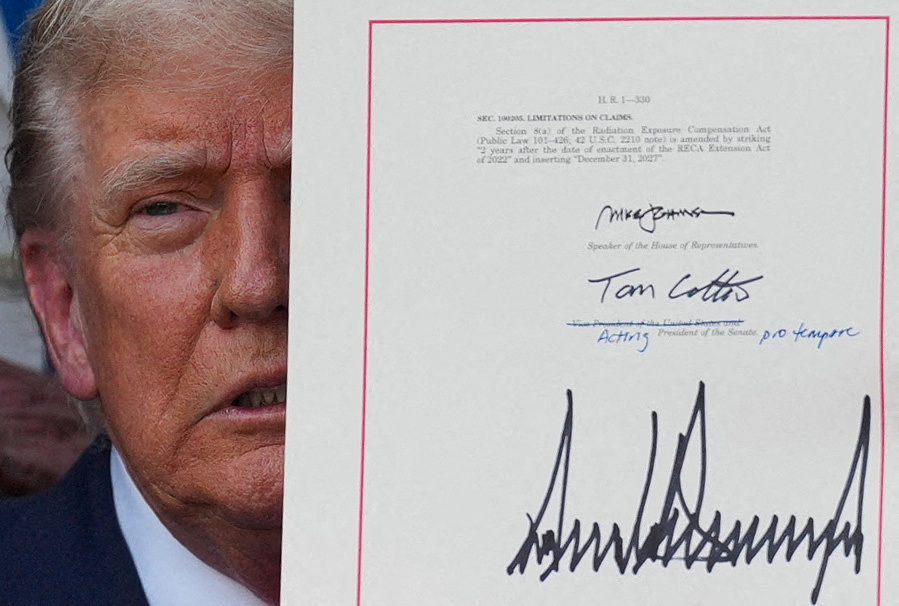The White House confirmed Friday that President Donald Trump will impose 25% tariffs on imports from Canada and Mexico on Saturday. White House press secretary Karoline Leavitt said at a press briefing that Trump will also impose an additional 10% tariff on goods from China.
Trump vowed during his campaign to impose tariffs on countries to halt the flow of migrants and fentanyl across their borders.
“These are promises made and promises kept by the president,” Leavitt said “Those tariffs will be for public consumption in about 24 hours tomorrow, so you can read them then.”
Trump had previously said he would levy the steep tariffs on day one of his presidency but later gave Mexico and Canada a deadline of Feb. 1 unless they tightened security at their borders.
Canadian Prime Minister Justin Trudeau said Friday that Canada would respond forcefully to Trump’s tariffs, signaling a potential for a trade war between the two North American allies.
Mexico President Claudia Sheinbaum said Friday that her administration has plans to counter the tariffs, depending on the form they take. “It is very important for the people of Mexico to know that we will always defend the dignity of our people, that we will always defend respect for our sovereignty, and engage in dialogue as equals, as we have always stated, without subordination,” she said at a press briefing.
Trump has also pledged to impose tariffs on all steel, computer chips, semiconductors and pharmaceuticals in a push to increase U.S. production of the products.
Will tariffs on goods from Canada, Mexico and China cost US citizens?
Trump has repeatedly and inaccurately stated that the other countries would pay for the tariffs, which are taxes on foreign imports, but additional costs such as tariffs are ultimately passed on to the consumer.
The proposed tariffs could cost consumers an additional $2,500 to $7,600 a year per household, according to estimates, said Jonathan Gold, vice president of supply chain and customs policy for the National Retail Federation.
“For consumers, tariffs are like another form of inflation, just spelled differently,” said Darpan Seth, CEO of Nextuple, which helps build and support programs to help its clients get products for consumers in stores or online. “They have the same effect of rising prices.”
While prices of many items across the country may rise, Florida imports some specific categories of materials.
What does Florida import from Mexico?
Mexico is Florida’s No. 1 trade partner and its third-largest exporter. In 2023, the state imported $10.4 billion in goods, according to the Mexican embassy (although Select Florida, the state’s official international commerce organization, only lists 4.3 billion), and exported more than $4 billion in aerospace products and parts, engines, turbines and power transmission equipment, miscellaneously manufactured commodities, paper products, dairy products, and more.
Imports:
- Motor vehicles: 30%
- Beverages: 7%
- Fruits and tree nuts: 6%
- Navigational, measuring, medical and control instruments: 5%
- Household appliances and miscellaneous machines: 5%
- Other: 47%
“Other” includes vegetables, meat, fish, alcohol, phones, oil, and a great deal more, all of which may go up in price.
What does Florida import from Canada?
In 2022, Canada was Florida’s third largest source of imports, with $408.7 million in repaired exports, $268.1 million of furniture, $230.1 million of bread, cakes and pastries, $201.4 million in refined petroleum and $197 million in turbojets and turbines, according to SelectFlorida.org.
Canada is also Florida’s largest export market. Canadian businesses and consumers imported $5.2 billion worth of Florida-origin goods in 2023, including fertilizer, civilian aircraft and engines, electrical circuits, yachts and other vessels and vaccines, human and animal blood.
Just a few weeks ago, the U.S. Food and Drug Administration finally approved a plan to allow Florida to import cheaper prescription drugs from Canada. Initially, the state plans to import drugs to treat conditions such as HIV and AIDS and mental illness through government programs such as Medicaid, the prison system and facilities run by the Florida Department of Children and Families.
It is not yet known if the price of those medications will be affected by the tariffs.
What does Florida import from China?
Florida, like the rest of the U.S, imports a lot of electronic goods from China, as well as vehicle parts, furniture parts, travel goods, handbags, wallets, toys, air conditioners, arcade game parts, lamps and lighting parts, plastics, household articles, bed linens and more.
Chinese-made items accounted for $12.43 billion of Florida’s imports in 2023, according to Select Florida.

